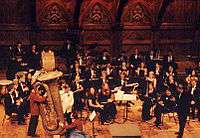Subcontrabass tuba
The subcontrabass tuba is an extension of the tuba family within the modern contrabass tuba. At least five known examples have been created, all pitched in BBBb, sounding a full octave lower than standard BBb contrabass tubas. Music for them is written in bass clef sounding a full octave lower than notated.

| Related instruments | |
|---|---|
| Tuba, Euphonium, Trombone | |
| Musicians | |
| Gerard Hoffnung | |
| Builders | |
| Adolphe Sax, Gustav Besson, the London firm of Paxman | |
| More articles or information | |
| This tuba is visible in the official Hoffnung website |
History
The first existence of an instrument of this sort was designed by the Parisian instrument innovator Adolphe Sax (1814–1894), the inventor of the saxophone, who dubbed it the subcontrabass saxhorn.[1] These instruments were all very rare and never received a great deal of attention.
The first two modern instruments were built by Besson on the suggestion of American Bandmaster John Philip Sousa, who toured using one in his band from 1896-1898.[2] One of this pair, the only known playable instrument of its kind, is owned by the Harvard University Band and is still played periodically in concerts.
In the 1950s, British musician Gerard Hoffnung commissioned the London subcontrabass tuba for use in his comedic music festivals, and also commissioned a work: Variations on "Annie Laurie" (1956) by Gordon Jacob, specifically including the instrument.[3][4] A tuba pitched in FFF was made in Kraslice by Bohland & Fuchs probably during 1910 or 1911 and was destined for the World Exhibition in New York in 1913[5] (Green). This tuba is "playable," but two persons are needed: one to operate the valves and one to blow into the mouthpiece. Finally, Dr. Frederick Young plays a King BBb tuba that was converted into a double tuba (in BBb and EEE (natural)) by Dietrich Kleine-Horst (of the Herbert Gronitz Brass Instrument Company in Hamburg, Germany) in 1990.[4] The BBb side is a contrabass tuba, and the EEE side is a subcontrabass tuba.
See also
References
- Horwood, Wally (1992). Adolphe Sax--His Life and Legacy. Baldock, Herts, England: Egon Publishers, Ltd.
p67
- McWhirter, Norris (1976). Guinness Book of World Records. 1976 edition. The original album has a picture of this instrument on the reverse side.: New York: Sterling Publishing.
- Hoffnung, Gerald (1961). Hoffnung's Music Festivals. Hayes Middlesex, England: BMI Music Publishing.
- Young, Frederick (November 1990). The Instrumentalist. Northfield, IL, USA. 45 (4). Missing or empty
|title=(help) - Green, Grant (1998). "Subcontrabass Tuba". Contrabass Digest. 1 (30).